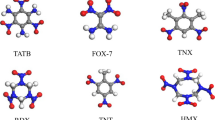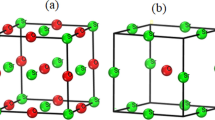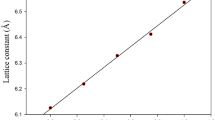Abstract
In the present study, the density functional theory method with various basis sets for optimizing and computing the structural and energetic properties of octasilacubane were performed at 298.15 K and 1 atmosphere. The data from the calculations on this compound show us the internal angles in the structure are 90 degrees. For this reason, the molecule has serious angular pressure. This angular strain is tolerated by a higher percentage of p-orbitals of silicon atoms in the Si-Si σ-bonds formation. According to calculation, σ (Si−Si) bonds in the octasilacubane system are formed from an sp3.44 d 0.02 hybrid. Also, IR and NMR spectra of the structure were simulated. The electronic chemical potential, the hardness and electrophilicity power of the molecule were obtained from frontier orbitals energies. The data show the structure has low electrophilicity. Heats of formation and detonation parameters were then calculated at studied levels of B3LYP (Becke, 3 parameter, Lee-Yang-Parr) theory. The simulation results revealed that this compound because for its high molecular weight is not a viable candidate of high energy density materials (HEDMs).
Similar content being viewed by others
References
Eaton PE, Cole Jr. TW (1964) J Am Chem Soc 86:3157–3158
Zhang M, Eaton PE, Gilardi R (401) Angew Chem Int Ed 39
Jursic BS (2000) J Mol Struct 499:137–140
Nagase S (1989) Angew Chem Int Ed Engl 28:329–330
Unno M (2014). In: Scheschkewitz D (ed) Functional Molecular Silicon Compounds II, vol 156. Springer, Heidelberg , pp 49–84
Unno M, Matsumoto H (2005). In: Auner N, Weis J (eds) Organosilicon Chemistry VI. WILEY-VCH Verlag, Weinheim, pp 373–380
Matsumoto H, Higuchi K, Kyushin S, Goto M (1992) Angew Chem Int Ed Engl 31:1354–1356
Matsumoto H, Higuchi K, Hoshino K, Koike H, Naoi Y, Nagai Y (1988) J Chem Soc Chem Commun 16:1083–1084
Mahkam M, Nabati M, Latifpour A, Aboudi J (2014) Des Monomers Polym 17:453–457
Mahkam M, Namazifar Z, Nabati M, Aboudi J (2014) Iran J Org Chem 6:1217–1220
Nabati M, Mahkam M (2014) Iran Chem Commun 2:164–169
Babler JH, Sarussi SJ (1983) J Org Chem 48:4416–4419
Derrick Clive LJ, Angoh AG, Bennett SM (1987) J Org Chem 52:1339–1342
Frisch MJ, Trucks GW, Schlegel HB, Scuseria GE, Robb MA, Cheeseman JR, Montgomery Jr JA, Vreven T, Kudin KN, Burant JC, Millam JM, Iyengar SS, Tomasi J, Barone V, Mennucci B, Cossi M, Scalmani G, Rega N, Petersson GA, Nakatsuji H, Hada M, Ehara M, Toyota K, Fukuda R, Hasegawa J, Ishida M, Nakajima T, Honda Y, Kitao O, Nakai H, Klene M, Li X, Knox JE, Hratchian HP, Cross JB, Adamo C, Jaramillo J, Gomperts R, Stratmann RE, Yazyev O, Austin AJ, Cammi R, Pomelli C, Ochterski JW, Ayala PY, Morokuma K, Voth GA, Salvador P, Dannenberg JJ, Zakrzewski VG, Dapprich S, Daniels AD, Strain MC, Farkas O, Malick DK, Rabuck AD, Raghavachari K, Foresman JB, Ortiz JV, Cui Q, Baboul AG, Clifford S, Cioslowski J, Stefanov BB, Liu G, Liashenko A, Piskorz P, Komaromi I, Martin RL, Fox DJ, Keith T, Al- Laham MA, Peng CY, Nanayakkara A, Challacombe M, Gill PMW, Johnson B, Chen W, Wong MW, Gonzalez C, Pople JA (2004) Gaussian 03. Revision B.01 . Gaussian Inc., Wallingford. CT
Vosko SH, Wilk L, Nusair M (1980) Can J Phys 58:1200–1211
Lee C, Yang W, Parr RG (1988) Phys Rev B 37:785–789
Miehlich B, Savin A, Stoll H, Preuss H (1989) Chem Phys Lett 157:200–206
Vatanparast M, Javadi N, Talemi RP, Parvini E (2014) Iran Chem Commun 2:317–326
Unno M, Matsumoto T, Mochizuki K, Higuchi K, Goto M, Matsumoto H (2003) J Organomet Chem 685:156–161
Türker L (2004) J Mol Struct (Theochem) 681:15–19
Glukhovtsev MN (1997) J Chem Educ 74:132–136
Parr R, Pearson RG (1983) J Am Chem Soc 105:7512–7516
Koopmans TA (1933) Physica 1:104–113
Parr RG, Szentpaly LV, Liu S (1999) J Am Chem Soc 121:1922–1924
Kybett BD, Carroll S, Natalis P, Bonnell DW, Margrave JL, Franklin JL (1966) J Am Chem Soc 88:626–626
Kamlet MJ, Jacobs SJ (1968) J Chem Phys 48:23–25
Author information
Authors and Affiliations
Corresponding author
Rights and permissions
About this article
Cite this article
Nabati, M., Mahkam, M. Computational Study of Octasilacubane Structural Properties with Density Functional Theory Method. Silicon 8, 461–465 (2016). https://doi.org/10.1007/s12633-014-9276-1
Received:
Accepted:
Published:
Issue Date:
DOI: https://doi.org/10.1007/s12633-014-9276-1




